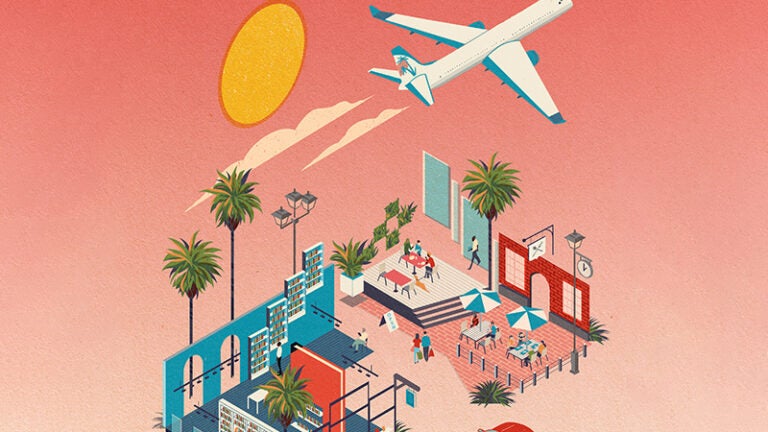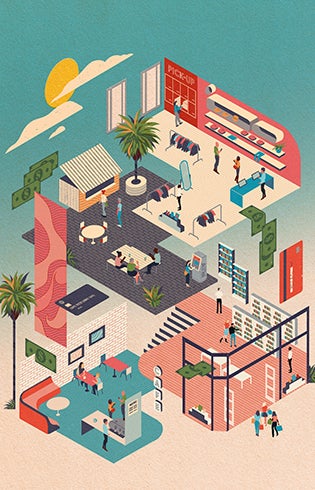
Notes on a Post-Pandemic Economic Revival
Jacob Soll is like a lot of Americans. (Except for the fact that he’s a MacArthur Genius.) He wants to get out and spend some money.
After working from his home office in Los Angeles for more than a year, Soll, who trained as a chef before becoming an academic, wants to dine out at his favorite restaurants, browse through a bookstore, travel — do those things that add spice to life.
“I know that I myself am going to spend money just flying around the world to catch up with family and friends … and just going out to dinner,” says Soll, University Professor and professor of philosophy, history and accounting at USC Dornsife. “I’m going to do it. We’re all desperate
to do it.”
And more people can now afford to do it.
As horrific as the COVID-19 pandemic has been, one of its few silver linings has been an increase in personal savings, thanks to government stimulus payments and a dearth of things to buy and do. Americans reportedly saved an extra $1.7 trillion during the pandemic, bringing total personal savings in the United States to $6.04 trillion at the end of March. The extra amount alone is almost identical to Canada’s gross domestic product (GDP) in 2019.
Economists roundly agree that consumers are ready to spend a good chunk of that money — though how much remains a matter of some debate. Granted, lower-income families are more likely to have to spend their stimulus checks on basic necessities, such as food and housing. But
people in higher income brackets who held onto their incomes have newfound spending power for trips to everything from manicurists to Monaco.
“Yes, we have more money saved, particularly because of the stimulus and the government payments to individuals,” says Wendy Wood, Provost Professor of Psychology and Business. “People may be ready to go out and take themselves on long-awaited vacations and buy things that they haven’t been able to really appreciate during lockdown.”
Soll agrees.
“If people get vaccinated and the virus is suppressed,” he predicts, “there will be a boom.”
But big questions remain. How much will consumers spend and what will they spend it on? To what degree will the post-COVID consumer economy change or remain the same? Who will benefit or lose? And can we use this transitional moment to build a more resilient economy?
“I don’t think people will spend everything quickly,” says Provost Professor of Psychology and Marketing Norbert Schwarz. “I think they will be scared that there will be additional waves of COVID coming. And, probably everybody will keep a little rainy-day fund because they’re worried that jobs may go away again.”
RETAIL DETAIL

Brick-and-mortar retail outlets were already under pressure from online shopping before the pandemic. In fact, more stores closed in 2019 than in 2020 — 9,300 compared to 8,300, according to Business Insider (although some estimates put the 2020 number at more than 12,000). Another 10,000 are predicted to close this year.
But as consumers open their wallets, new retail businesses will open their doors. However, Soll says mom-and-pop outfits may have difficulty competing. Bigger, more well-capitalized ventures will have an edge in reopening shuttered retail spaces.
“The big money will have a lock on much of it,” Soll says. “And you’re going to see a lot of extinction of the small personal places because many people and small businesses got cleaned out trying to stay alive during COVID and ended up getting wiped out. That said, I think it will be a great moment for entrepreneurs and smart investors who can adapt and capitalize on this boom.”
With many consumers still traumatized by their first pandemic, business may not want to go back to business as usual. For those operations that have the good fortune to remain open, attracting consumers may require a fresh approach, especially during the initial stages of reopening.
For example, restaurants that continue to offer heated outdoor dining, fan-driven light breezes and hand sanitizer may have an advantage. It’s the same for stores when it comes to offering a safe environment.
“If people get vaccinated and the virus is suppressed, there will be a boom.”“The basic principle of marketing post-pandemic enjoyment is that you want to be sensitive to your customers and convey that you meet their desires,” Schwarz says. “And so, if you have the kind of business, or are in the kind of location, where people are worried about COVID, then you have to say, ‘No reason to worry, we make it safe. So, come here, wear your mask, sanitize your hands and keep your distance — isn’t it wonderful?’ And, if you’re in a place where people don’t care and think it’s all just a nuisance, then you say, ‘We don’t care, either. Come in here, it’s nice and crowded.’ But beware, the next surge may ruin that strategy.”
HABITS DIE HARD? OR NOT
The future of consumer spending will rest in part on habits that last and those that wilt away. For example, if you took up gardening during the pandemic, will you still be buying planters and that cute, steel watering can if you’re spending your mornings and evenings stuck in traffic?
“Simply because you did it a lot during the pandemic — or you found it enjoyable — doesn’t mean you’re necessarily going to continue after the pandemic ends. It really depends on whether your family goes back to pre-pandemic work and school schedules,” says Wood, who researches how habits are made and broken. “Even if you formed a habit of making dinner at home during the pandemic — and started to like your own cooking — you won’t necessarily continue when you go back to work or into the office. The cues that triggered your cooking habit — being in the kitchen at 5 p.m., for instance — won’t be there anymore. Instead, you will likely fall back into old work habits from before the pandemic. Driving home by that take-out restaurant will trigger your old dinner take-out habit.”
One of the most ingrained habits — and it didn’t take long to develop — is shopping online.
Online shopping was already on the rise prior to the pandemic, and being locked down only introduced its convenience to more consumers. E-commerce retail sales were 14% of total sales during the fourth quarter of 2020, down from a peak of 16.1% in the second quarter — when the pandemic first took hold — but up from only 4.6% a decade earlier, according to the Federal Reserve. Estimates vary, but U.S. consumers spent more than $860 billion online last year — up 44% compared to the previous year.
“Even older consumers, who weren’t buying much online before the pandemic, have now formed habits to do so,” Wood says.
Post-pandemic, the cues to our online purchasing will still be there. So consumers are likely to continue going online to buy everything from jewelry to kitty litter.
But not everything is going online. We will still get out, Wood predicts, especially when it comes to shopping for clothes. She says consumers will probably return to their favorite stores to try on garments and make an outing of it with friends.
Pablo Kurlat, associate professor of economics, agrees with his colleagues that consumer spending will accelerate as the pandemic wanes. But he says there are still a lot of unknowns.
“So,” he asks, “are we going to go back to consuming about as much as we would have, had this not happened? And if that happens, how fast? And then, are we going to choose a different bundle of goods to consume than we would have if this hadn’t happened?”
There are two schools of thought about how Americans will — or won’t — part with their newfound savings.
The first, known as Ricardian equivalence, holds that consumers will hang on to their stimulus checks because they know they’re going to be taxed to recoup some of the massive financial outlay that the government used to stabilize and revive the economy. In this case, Kurlat points out, “getting money from the government doesn’t change anything in terms of how much you consume.”
The second model is less rational but more familiar: People spend the money they can, without heed to the future.
“The truth is somewhere in between, probably,” Kurlat says. “Exactly where in between, we don’t know.”
BOOM OR BUST
With consumer spending accounting for 70% of the nation’s GDP, there’s no question that how, where and when people spend their savings will have a major impact on tomorrow’s economy. But there are related factors to consider as we emerge from this grim period and reassess our priorities.
Putting an end to the COVID-19 pandemic is, without doubt, a once-in-a-generation reason to celebrate. But Soll says we have to be careful not to bring on a global hangover by spending recklessly and neglecting to use this moment as an opportunity to build a better economy.
“If America can remain united and work on its strengths, which happen to be its giant research sector and its creative sector, and if America can hold together, then I think it will come out stronger,” Soll says. “But those are big ifs.”
Just as the U.S. did after World War II, Soll believes this is the moment for government to renew investment in academic research, which for generations has been
the driver of innovation. The Global Positioning System, the internet, modern treatments for cancer and a host of other diseases — these and numerous other advancements started as fundamental research projects in universities.
“We have a huge scientific powerhouse structure, the biggest in the world,” Soll says. “But if we don’t invest in it, we’re going to be left behind. We’re living on what we built before.”